23 JULY – 14 AUGUST 2024
By Chris Lotz
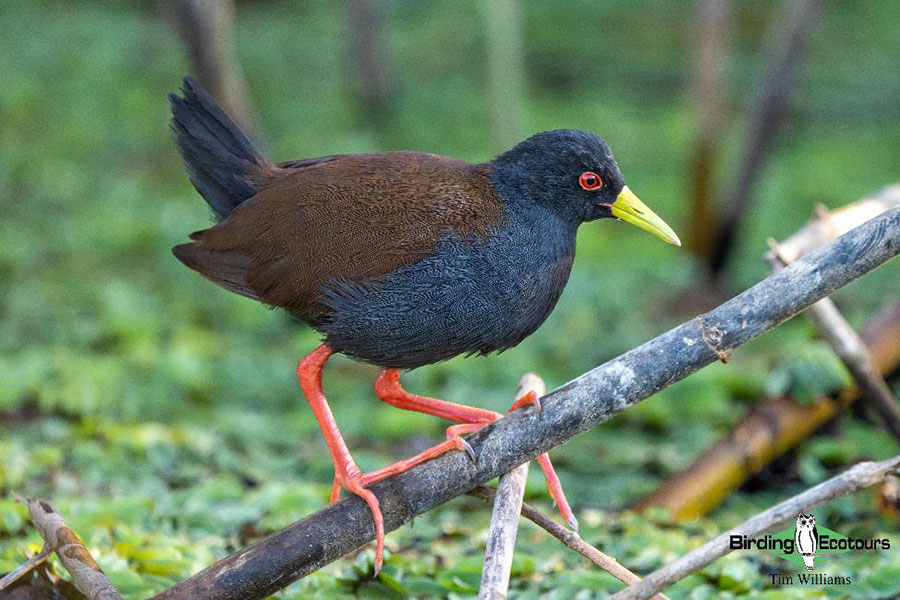
The localized Sakalava Rail was one of our top six targets and we enjoyed great views! This and some other photos in this report are by Tim Williams who participated in this tour (see watermarks on each photo)
Overview
This was a brilliant trip in which we found five of our six “off the beaten track” bird species, occurring in such remote areas that there is no chance of seeing them on standard Madagascar birding itineraries. These were the beautiful Sakalava Rail, the unusual rock-climbing Tsingy Forest Rail, the rare Slender-billed Flufftail (we also saw its more common relative, Madagascar Flufftail), Red Owl and the Critically Endangered Madagascar Pochard. We missed laying eyes on Madagascar Serpent Eagle (although we did hear it once). In addition to finding all but one of our major remote Madagascar targets, we also cleaned up on the classic northwestern Madagascar (Ankarafantsika National Park) birds such as Schlegel’s Asity, White-breasted Mesite, Van Dam’s Vanga, Madagascar Fish Eagle, Madagascar Jacana, Bernier’s Teal, Malagasy Sacred Ibis, etc. On our Kirindy/Tsingy leg, where the main target was the forest rail, we were very pleased to also find a close-up Banded Kestrel, along with one of the island’s weirdest mammals, Fosa, and superb scenery in the form of the spectacular Tsingy rock formations and the Avenue of the Baobabs.
Madagascar Pochard were seen on Lake Bemanevika.
Part of the trip involved remote camping and truly awful roads (Bemanevika requires a grueling two and a half day drive each way), but we interspersed these more difficult sections with a bit of much-appreciated luxury. It’s all relative, so the basic hotel at Antsohihy felt like luxury after the camping, but we did also use some four-plus star places, when available, near our bird and mammal targets, including some idyllic beach hotels.
After arriving in Antananarivo (Tana), we took a flight to Majunga (Mahajanga) in north-western Madagascar. For the bulk of this remote Madagascar birding tour, we used Majunga as a “hub”. From here, we accomplished many great things. To start with, we headed to Lake Kinkony for our first major target, Sakalava Rail, also finding many more common and widespread Malagasy endemics. After returning to Majunga for a night, we then enjoyed a boat trip into the mangroves of the Betsiboka Delta, finding Crab-plover, Bernier’s Teal, Malagasy Sacred Ibis and other goodies. We then spent a couple of days birding Ankarafantsika National Park (Ampijoroa) for classic north-western Madagascar bird species that are the usual focus of our north-western Madagascar birding tour. From Ankarafantsika National Park we embarked on an arduous two day drive to Bemanevika, a beautiful rainforest site in a remote part of northern Madagascar. This stunning area contains gorgeous crater lakes and supports some of the rarest birds in Madagascar, which few people will ever have the privilege of seeing. After seeing three of our four major targets here, plus a lot of other great birds, we spent three days driving back to Majunga.
The final week of our trip was in central western Madagascar, using Morondava as a “hub”. This is a popular area for general (non-birding) tourists because of the Avenue of the Baobabs, the impressive rock formations of Tsingy de Bemaraha National Park, and the great mammals including Fosa (it’s the best place in the world to see this weird carnivore) and Decken’s Sifaka.
All in all, this was a highly successful trip. Not only did we find five of the six rarely seen Madagascan bird species, but we also saw a host of other great bird and mammal endemics, unusual plants and wonderful scenery.
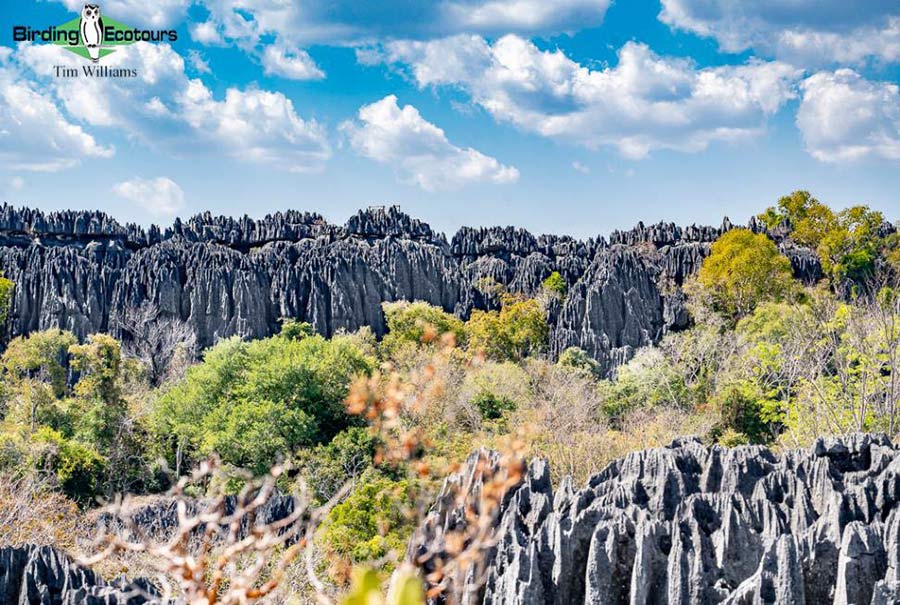
Tsingy de Bemaraha National Park (Grand Tsingy)
Detailed Report
Day 1, 23rd July 2024. Birding Lake Tsarasaotra and flight to Majunga
We had breakfast with close-up Madagascar Wagtails and Malagasy Bulbuls at our hotel.
Our flight from Antananarivo (Tana) to Majunga was delayed until the late afternoon, which gave us a good opportunity to head to Parc de Tsarasaotra (Lac Alarobia). Here, we were very pleased to get close-up views of a couple of Meller’s Ducks along with hundreds of Red-billed Teals, a few Blue-billed Teals, hundreds of White-faced Whistling Ducks plus a single Fulvous Whistling Duck, and a couple of Knob-billed Ducks. Large numbers of herons were also around, listed here in order of abundance, with hundreds of Dimorphic Egrets, fewer (but still a great many!) Black Egrets (some of them doing their remarkable umbrella fishing), Black-crowned Night Herons, Squacco Herons, Striated Herons and Great Egrets. A couple of White-throated Rails co-operated quite well, albeit fairly briefly.
Several Malagasy Kingfishers sat like jewels. A pair of Malagasy Coucals showed and called, and a pair of Madagascar Hoopoes (noticeably larger than “normal” hoopoes) showed briefly. A Madagascar Swamp Warbler showed very well and sang nicely for us, but Malagasy Brush Warblers proved more skulking, only showing briefly. Madagascar Mannikins showed nicely for a few seconds.
All in all, this was a solid start to our Madagascar birding, not bad for what was meant to be a travel day.
Day 2, 24th July 2024. Travel from Majunga to Lake Kinkony
After a leisurely breakfast, we took the ferry across the “other-worldly” Bombetoka Bay (essentially the impressive Betsiboka River estuary). We then embarked on the long, dusty journey to Lake Kinkony (including a couple of further ferry crossings as well) where we would spend two nights camping. We did see some nice birds along the way, such as our first vanga, Chabert Vanga, at our lunch stop.Arriving at Lake Kinkony in the late afternoon, we enjoyed a beautiful sunset over the lake and then later a scrumptious meal under an extremely impressive Milky Way.
Day 3, 25th July 2024. Superb views of some Sakalava Rails!
After being kept awake by Madagascar Nightjars, which we glimpsed this morning, we had an early breakfast and then took a Lake Kinkony boat trip. We concentrated mainly on the backwater areas behind reeds where, after quite a lot of searching, we eventually located our main target, Sakalava Rail! We initially found a pair of them, which co-operated very well, giving close views. A bit later, we found a single bird that performed even better, spending quite a lot of time in the open in excellent light. What a bird, arguably a bit toy-like with its luminous colors. It’s always great to see one of Madagascar’s most localized bird species, not one that is seen on your average Madagascar birding tour.
The boat trip was also excellent for a range of other excellent birds. Madagascar Jacanas showed very close-up in good light. Herons, egrets and other waterbirds abounded, although we’d already seen many of them in Tana on the first day of the tour. The spectacle of lots of Black-crowned Night Herons, Black Herons, and other species flying around actively in the early morning light, was wonderful. There were also some new species we hadn’t seen yet, like Purple Herons, hundreds of Glossy Ibises and others. A few African Swamphens and Common Moorhens also put in appearances.
Splashes of bright color came in the form of Olive (Madagascar) Bee-eaters and Malagasy Kingfishers. There were also numerous LBJs (Little Brown Jobs), the most abundant being Madagascar Swamp Warbler, with smaller numbers of Madagascar Cisticolas.
Hundreds of Malagasy Palm Swifts flew above us. Pairs of Malagasy Coucals dueted from the reedbeds. There were quite good numbers of Malagasy Turtle Doves around.
When we got back to the shore where we were camping, we saw a Yellow-billed Stork flying over.
After resting for a few hours in the heat of the day, we went on an hour long birding walk near the end of the day. This was successful, as we added some more excellent birds to our growing list. Beautiful, sweet Grey-headed Lovebirds showed well, as did a Malagasy Paradise Flycatcher. We enjoyed great views of a dainty little long-tailed Namaqua Dove on the ground (we saw a great many of these later in the trip). A couple of Crested Drongos and Madagascar Magpie Robins were, as always, noisy. A good number of Soimanga Sunbirds were around (another common bird in Madagascar but always nice to see the first one and, like most sunbirds, it’s a gorgeous-looking bird).
Day 4, 26th July 2024. Drive back towards Majunga
We were ahead of ourselves as we had already seen the main target, Sakalava Rail (with better views and photos impossible), so we started heading back most of the way to Majunga and enjoyed the reward of a beach hotel for the night instead of a third night of camping.Although this was mainly a travel day, we did end the day with two Critically Endangered (IUCN) lemurs, Mongoose Lemur and Crowned Sifaka, as well as a Vulnerable one, Red-fronted Brown Lemur. While watching these lemurs, we enjoyed spectacular views over the Mozambique Channel from around the lighthouse.
Day 5, 27th July 2024. Majunga
After taking the ferry crossing, we had a relaxing day around Majunga, enjoying another night at the beach hotel while regrouping for the next exciting part of the trip.
Day 6, 28th July 2024. Betsiboka Delta boat trip and transfer to Ankarafantsika National Park
We had a relaxed start to the day as we wanted to bird on the outgoing tide, meaning we only started our boat trip at 11 am, having lunch on the boat. This boat trip was very successful, and we found eleven Bernier’s Teals, a similar number of Malagasy Sacred Ibises, a handful of beautiful Crab Plovers (one of the world’s truly charismatic bird species) and a few hundred Lesser Flamingos. There were stacks of Dimorphic Egrets, the dark form slightly outnumbering the white ones, unlike in Tana where they were all white. We also saw a few shorebirds such as Common Greenshank, Eurasian Whimbrel and Common Sandpiper.
After getting back to the shore, we embarked on our four hour road transfer to Ankarafantsika National Park, where we would spend the next three nights. This is a famous park for some of Madagascar’s most stunning endemics, birds we do see on our standard tours and which we cleaned up on during this trip as well (why not, since we were in the area?).
Day 7, 29th July 2024. Ankarafantsika National Park dry forest birding
This was an awesome day! The best bird of our early morning Ankarafantsika (Ampijoroa) birding was the spectacular Schlegel’s Asity. But we also enjoyed seeing Madagascar Green Pigeons, a close-up Madagascar Sparrowhawk, Hook-billed Vanga, Rufous Vanga, Crested Coua, Red-capped Coua, Coquerel’s Coua, a beautiful day-roosting Torotoroka Scops Owl, Common Newtonia, Long-billed Berniera and various others.
Mammal-wise, this morning’s session around the park allowed us great sightings of Coquerel’s Sifaka and a Milne-Edwards’s Sportive Lemur. Both of these are super-amazing animals!
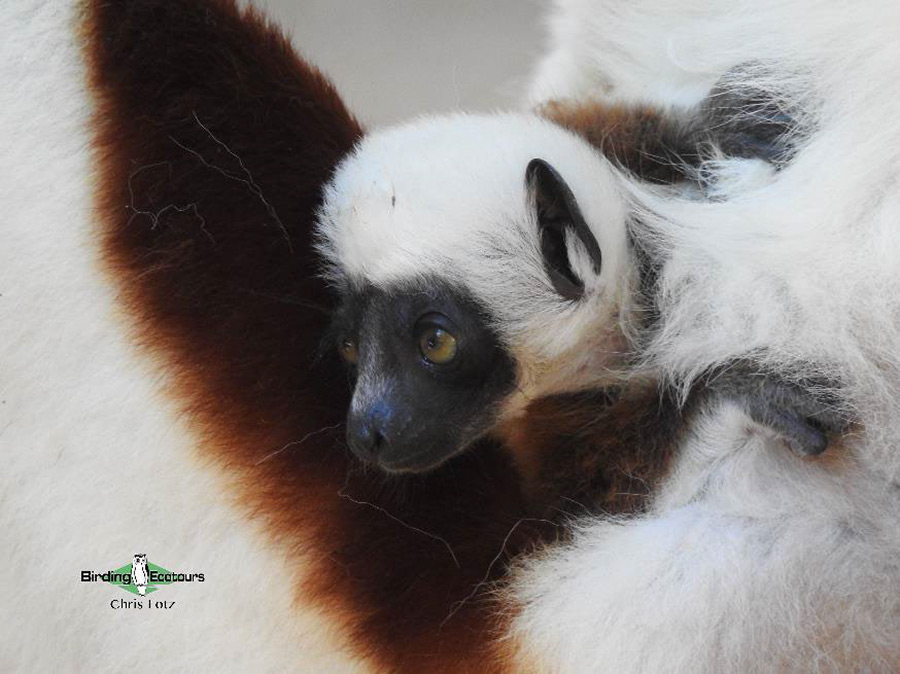
A baby Coquerel’s Sifaka at the Ankarafantsika National Park headquarters
After a nice lunch and a couple of hours of resting back at the lodge, we embarked on a boat trip around Lac Ravelobe. A nesting pair of Critically Endangered Madagascar Fish Eagles was the real highlight. We also enjoyed seeing many other birds, including Madagascar Jacana, African Openbill, various egrets, and herons including several close-up Purple Herons.
The highlight of a late afternoon walk in the forest was seeing White-breasted Mesites very well and remarkably close-up. We ended the day’s birding with a flock of at least 16 Sickle-billed Vangas (a spectacular bird) coming in to roost, with Brown Lemurs vying for attention.
Last but not least, we enjoyed a night walk in the forest for about an hour. This proved spectacular, with three Golden-brown Mouse Lemurs, a Western Wooly Lemur and a Mongoose Lemur. Also on the walk was a bizarre Rhinoceros Chameleon, a massive Oustalet’s Chameleon, a stunningly beautiful Madagascar Day Gecko and a minute Grandidier’s Dwarf Gecko.
Day 8, 30th July 2024. A second day of Ankarafantsika National Park dry forest birding
The morning session went so well that we finished early and managed to earn ourselves a long break until late afternoon. We started the morning with an obliging Frances’s Sparrowhawk in the car park. Along the sandy forest trail, the second new trip bird was a male Madagascar Buttonquail (unusually for birds, the males are drabber in buttonquails). Three White-headed Vangas, a pair of very localized Van Dam’s Vangas and a stunning Madagascar Blue Vanga all put on shows for us. A Cuckoo-roller perched well in good light and gave magnificent views, as did a Lesser Vasa Parrot, with several Greater Vasa Parrots flying over us. A Madagascar Hoopoe (a chunk larger than its African/Eurasian cousins and with a different call, which we enjoyed listening to!) showed well. We also went back to enjoy another view of the Torotoroka Scops Owl at its daytime roost. We also loved seeing an even cuter (than the tiny owl) family of Western Sportive Lemurs cuddling together at their roost.
We then did a quick check on the lake again (Lac Ravelobe) and found our main target easily, thanks to the site guide’s scouting. This was Humblot’s Heron, the only major miss during our boat trip the previous day.
After a long rest to recharge our own batteries, as well as those of our cameras and other equipment, in preparation for the adventurous remote part of this trip, we ended the day with a short birding session to go and see/photograph the impressive Sickle-billed Vanga roost again. What a bizarre bird, and how amazing to see such a large number of them coming in to roost, making their strange calls; a very atmospheric experience.
Day 9, 31st July 2024. First of two days of driving to Bemanevika
We spent the day driving to Antsohihy on our way northeastwards towards Bemanevika. The road today was still sort of alright, compared to the adventure that awaited us tomorrow (it’s all relative!).
Day 10, 1st August 2024. Second of two days of driving to Bemanevika
This was a hugely long drive on terrible roads. We did see good numbers of Madagascar Larks on the roadside, but didn’t have time to stop so had to leave this species for later in the trip (it’s common around the Bemanevika campsite though, so not to worry). We arrived late at night; this remote Madagascar trip was amazing for rare species but did have tough driving days, as well as a bit of camping (here at Bemanevika and also previously at the Sakalava Rail site). If you don’t like these sorts of things then its best to stick to our usual Madagascar trips, not this remote area one. Nevertheless, many people forget the bad parts quickly and remember the good parts for decades. So perhaps don’t write this remote Madagascar tour off too quickly.
Day 11, 2nd August 2024. Spectacular Bemanevika birding!
The morning was incredible! On a boat trip on a beautiful crater lake, we saw a large proportion of the world’s Madagascar Pochard population. This Critically Endangered species was thought to be extinct until it was rediscovered away from Lake Alaotra here at Bemanevika. The boat trip also generated numerous other species, such as a number of Meller’s Ducks, Red-billed Teals, White-faced Whistling Ducks, Madagascar Grebe,many Little Grebes and a couple of Red-knobbed Coots (uncommon in Madagascar). Madagascar Martins foraged around the edge of the lake, and Madagascar Swamp Warblers sang very nicely from within the reeds.
One of the other top birds of the morning was a gorgeous Red Owl at its daytime roost – what a bird! Other species in the forest included a pair of Red-tailed Vangas, a Red-fronted Coua and some others.
During lunch, we enjoyed quite good birds around the camp, Madagascar Cuckooshrike being new for the trip.
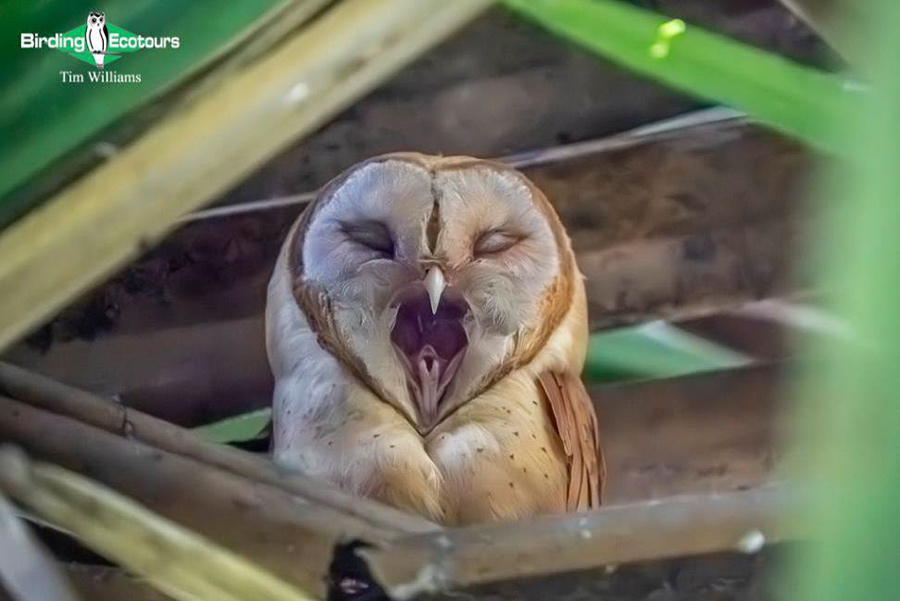
A tired Red Owl yawning
In the afternoon, we headed out to look for Slender-billed Flufftail and were not disappointed. What a bird! And we saw it very well. We heard a Madagascar Serpent Eagle but, sadly, did not lay eyes on it, while looking for the flufftail.
Day 12, 3rd August 2024. A second full day of Bemanevika birding!
Birds around our campsite during breakfast were great. We saw a few Madagascar Starlings, Madagascar Stonechats, Meller’s Ducks, close-up White-throated Rails and several other bird species.
As we left the camp for the morning birding session, we enjoyed great views of a few Madagascar Larks and a Madagascar Cisticola.
The morning birding a couple of miles from the camp did not disappoint, with highlights being a very close-up Madagascar Flufftail to compare with the previous day’s much rarer Slender-billed Flufftail, the day-roosting Red Owl again, gorgeous Madagascar Paradise Flycatchers, etc.
After lunch, we headed out birding again, stopping for a pair of Madagascar Partridges just outside the camp; this can be a tricky bird, so we were ecstatic! Sadly, we failed to find Madagascar Serpent Eagle during the afternoon session, but we did see other good birds while trying. These included a Blue Coua and various others. We saw some Madagascar Nightjars as we emerged from the forest.
After dinner, we had a run-around for a couple of vocal Rainforest Scops Owls, eventually seeing this beaut really well.
Day 13, 4th August 2024. Drive to Antsohihy
Today we began our arduous journey back to Majunga, overnighting in Antsohihy again. We managed to add one new trip bird to our list, Malagasy Green Sunbird. This was next to a cute and shiningly colorful (well, the male anyway) pair of Souimanga Sunbirds busy building a nest in a flowering tree that clearly provided a great source of nectar.
Day 14, 5th August 2024. Drive to Ankarafantsika
This was another travel day, the price one has to pay for the Bemanevika birds.
Day 15, 6th August 2024. Drive to Majunga
We drove the 3.5 hours to Majunga and had a restful afternoon at our beach hotel.
Day 16, 7th August 2024. Flight to Tana
We took a morning flight to Tana and had the afternoon to relax and regroup before the final leg of our journey.
Day 17, 8th August 2024. Flight to Morondava and start of amazing western Madagascar birding
We took a morning flight to Morondava, in central western Madagascar, and immediately started driving towards Kirindy, where we would spend one night. We enjoyed some time at the famous “Avenue of the Baobabs”, before driving 1.5 hours to our lodge, where we checked in and then had lunch.
After lunch, we headed to Kirindy Forest Reserve for some amazing mammal-watching and birding. As we arrived, we enjoyed our first lemurs of this area, a few Verreaux’s Sifakas.We then located some excellent birds, including our first Giant Coua. We were also very lucky to see a Narrow-striped Boky (a kind of mongoose) crossing the road in front of us! We then heard news that a Fosa had arrived at the park lodgings, and we rushed back to see this amazing, weird and wonderful carnivore. After a little while, a second one turned up! Sort of unfortunately (although it makes seeing the species far easier to find), this animal scavenges the trash around the park accommodation.
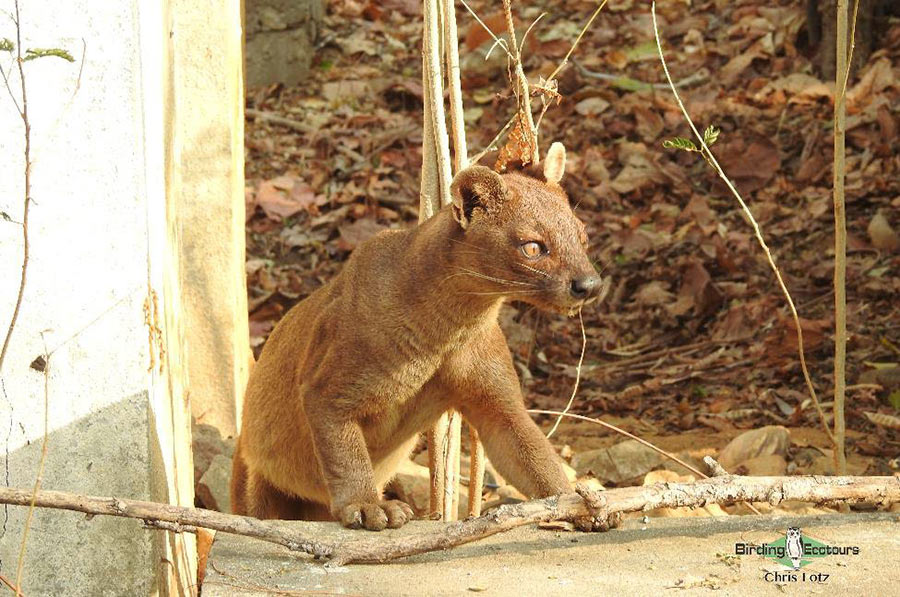
A Fosa came looking for food!
We then embarked on an evening walk in Kirindy Forest, finding several new lemurs and two different snake species. The lemurs were Grey Mouse Lemurs (one of them really close-up!), a couple of Pale Fork-marked Lemurs and a Red-tailed Sportive Lemur. The snakes were a Pencil Snake and a Common Madagascar Cat Snake. We also enjoyed seeing a Golden Orb-web Spider.
After the night walk, we headed back to the park’s headquarters to try for White-browed Owl and were not disappointed, enjoying two of them.
Day 18, 9th August 2024. Drive to Tsingy de Bemaraha National Park
What was meant to be just a travel day to get to the very comfortable Tsingy lodge we would be staying at for three nights, actually turned out to be an exciting birding day! The bird of the day was a close-up Banded Kestrel, an often elusive bird, and we enjoyed seeing this as we drove through the Kirindy Forest. We also saw numerous other birds we’d already seen but, in many cases, getting better views today, e.g. both species of vasa parrot. It was an interesting drive today, with two ferry crossings. A highlight was also the best lunch (so far) of the trip (we had exactly the same lunch a couple of days later on the way back, though). We eventually arrived at our lodge at 4.30 pm, with some time to relax and regroup before dinner.
Day 19, 10th August 2024. The Little Tsingy
This morning we searched for Tsingy Forest Rail at the Little Tsingy, but only heard three of them without managing to lay eyes on any. The spectacular scenery was some compensation, as were excellent views of Decken’s Sifakas and a Red Forest Rat. A couple of Black-winged Stilts along the river were new for the tour. We also saw a couple of Crab Spiders and numerous birds and other wildlife we’d already seen earlier in the trip.
We had another unsuccessful try for Tsingy Forest Rail this afternoon.
Day 20, 11th August 2024. Tsingy Forest Rail and the Great Tsingy!
Worried about dipping our major target after yesterday’s failed attempts, we started early, but this time heading for the forests around the spectacular Great Tsingy. After a couple of hours of searching, we eventually located a beautiful, confiding pair of Tsingy Forest Rails! They foraged on the leaf litter close to the trail, and then started climbing and foraging on rocks. What a bird! And such great, prolonged views. Hooray!
We also found the localized Bemaraha Sportive Lemur and enjoyed good views of some other lemurs and birds we’d already seen previously. And, we added a new chameleon to our list, Nicosia’s Chameleon.
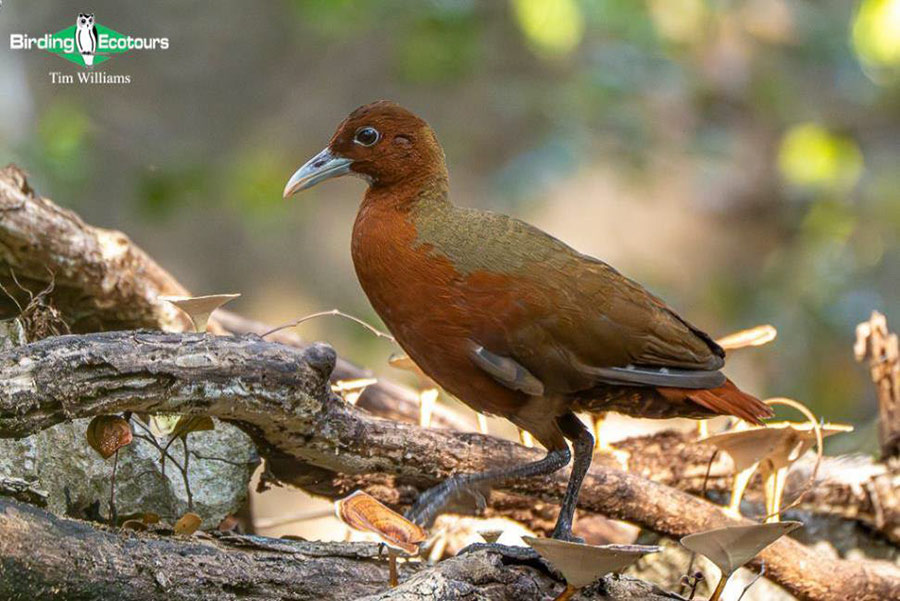
Tsingy Forest Rail!
Day 21, 12th August 2024. Drive back to Morondava
We drove back to Morondava, stopping to photograph the Avenue of Baobabs at sunset. Spending a couple of hours at this place is a memory that will be with us forever.
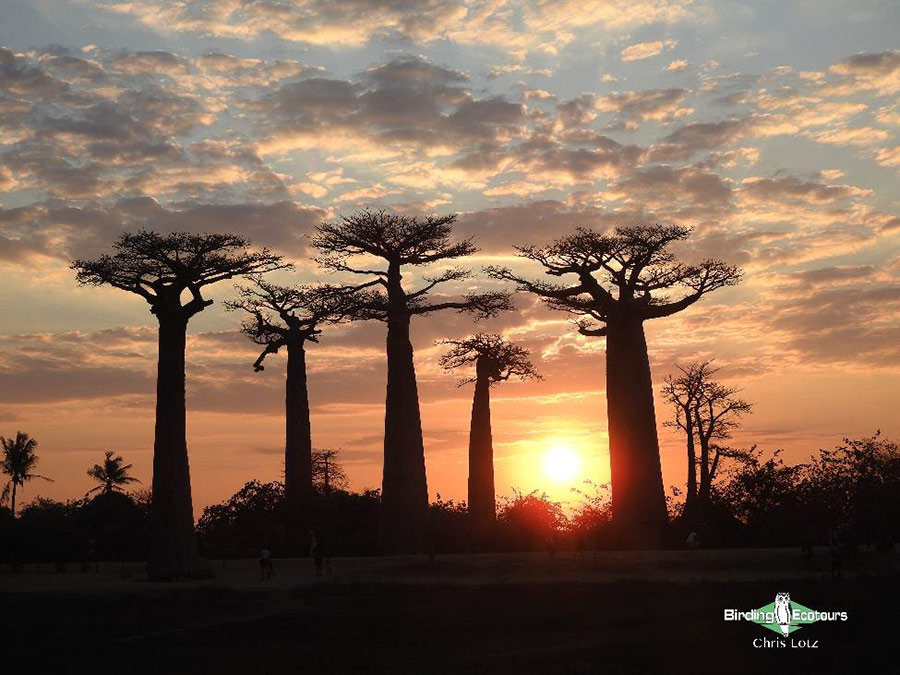
Sunset at the Avenue of the Baobabs.
Day 22, 13th August 2024. Flight back to Tana
We flew back to Tana, where the tour ended. What a super-amazing adventure this trip proved to have been!
Bird List – Following IOC (December 2023 version)
Birds ‘heard only’ are marked with (H) after the common name, all other species were seen. The following notation after species names is used to show conservation status following BirdLife International: CR = Critically Endangered, EN = Endangered, VU = Vulnerable.
| Common name | Scientific name |
| Ducks, Geese, Swans (Anatidae) | |
| White-faced Whistling Duck | Dendrocygna viduata |
| Fulvous Whistling Duck | Dendrocygna bicolor |
| Knob-billed Duck | Sarkidiornis melanotos |
| Blue-billed Teal | Spatula hottentota |
| Meller’s Duck – EN | Anas melleri |
| Red-billed Teal | Anas erythrorhyncha |
| Bernier’s Teal – EN | Anas bernieri |
| Madagascar Pochard – CR | Aythya innotata |
| Guineafowl (Numididae) | |
| Helmeted Guineafowl | Numida meleagris |
| Pheasants & Allies (Phasianidae) | |
| Madagascar Partridge | Margaroperdix madagarensis |
| Nightjars (Caprimulgidae) | |
| Madagascar Nightjar | Caprimulgus madagascariensis |
| Swifts (Apodidae) | |
| Madagascar Spinetail | Zoonavena grandidieri |
| Malagasy Palm Swift | Cypsiurus gracilis |
| Malagasy Black Swift | Apus balstoni |
| Cuckoos (Cuculidae) | |
| Malagasy Coucal | Centropus toulou |
| Crested Coua | Coua cristata |
| Blue Coua | Coua caerulea |
| Red-capped Coua | Coua ruficeps |
| Red-fronted Coua | Coua reynaudii |
| Coquerel’s Coua | Coua coquereli |
| Giant Coua | Coua gigas |
| Madagascar Cuckoo | Cuculus rochii |
| Mesites (Mesitornithidae) | |
| White-breasted Mesite – VU | Mesitornis variegatus |
| Pigeons, Doves (Columbidae) | |
| Malagasy Turtle Dove | Nesoenas picturatus |
| Namaqua Dove | Oena capensis |
| Madagascar Green Pigeon | Treron australis |
| Flufftails & Forest Rails (Sarothruridae) | |
| Tsingy Forest Rail – VU | Mentocrex beankaensis |
| Madagascar Flufftail | Sarothrura insularis |
| Slender-billed Flufftail | Sarothrura watersi |
| Rails, Crakes & Coots (Rallidae) | |
| White-throated Rail | Dryolimnas cuvieri |
| Common Moorhen | Gallinula chloropus |
| Red-knobbed Coot | Fulica cristata |
| African Swamphen | Porphyrio madagascariensis |
| Sakalava Rail – EN | Zapornia olivieri |
| Grebes (Podicipedidae) | |
| Little Grebe | Tachybaptus ruficollis |
| Madagascar Grebe | Tachybaptus pelzelnii |
| Flamingos (Phoenicopteridae) | |
| Lesser Flamingo | Phoeniconaias minor |
| Buttonquail (Turnicidae) | |
| Madagascar Buttonquail | Turnix nigricollis |
| Stilts, Avocets (Recurvirostridae) | |
| Black-winged Stilt | Himantopus himantopus |
| Jacanas (Jacanidae) | |
| Madagascar Jacana – EN | Actophilornis albinucha |
| Sandpipers, Snipes (Scolopacidae) | |
| Eurasian Whimbrel | Numenius phaeopus |
| Madagascar Snipe – VU | Gallinago macrodactyla |
| Common Greenshank | Tringa nebularia |
| Crab-plover (Dromadidae) | |
| Crab-plover | Dromas ardeola |
| Gulls, Terns, Skimmers (Laridae) | |
| Whiskered Tern | Chlidonias hybrida |
| Storks (Ciconiidae) | |
| African Openbill | Anastomus lamelligerus |
| Yellow-billed Stork | Mycteria ibis |
| Ibises, Spoonbills (Threskiornithidae) | |
| Malagasy Sacred Ibis – EN | Threskiornis bernieri |
| Glossy Ibis | Plegadis falcinellus |
| Herons, Bitterns (Ardeidae) | |
| Black-crowned Night Heron | Nycticorax nycticorax |
| Black Heron | Egretta ardesiaca |
| Dimorphic Egret | Egretta dimorpha |
| Striated Heron | Butorides striata |
| Squacco Heron | Ardeola ralloides |
| Western Cattle Egret | Bubulcus ibis |
| Great Egret | Ardea alba |
| Grey Heron | Ardea cinerea |
| Purple Heron | Ardea purpurea |
| Humblot’s Heron – EN | Ardea humbloti |
| Kites, Hawks, Eagles (Accipitridae) | |
| Madagascar Harrier-Hawk | Polyboroides radiatus |
| Madagascar Serpent Eagle – EN (H) | Eutriorchis astur |
| Madagascar Cuckoo-Hawk | Aviceda madagascariensis |
| Frances’s Sparrowhawk | Accipiter francesiae |
| Madagascar Sparrowhawk | Accipiter madagascariensis |
| Malagasy Harrier – EN | Circus macrosceles |
| Yellow-billed Kite | Milvus aegyptius |
| Madagascar Fish Eagle – CR | Icthyophaga vociferoides |
| Madagascar Buzzard | Buteo brachypterus |
| Barn Owls (Tytonidae) | |
| Red Owl – VU | Tyto soumagnei |
| Owls (Strigidae) | |
| White-browed Owl | Athene superciliaris |
| Torotoroka Scops Owl | Otus madagascariensis |
| Rainforest Scops Owl | Otus rutilus |
| Madagascar Owl | Asio madagascariensis |
| Cuckoo-roller (Leptosomidae) | |
| Cuckoo-roller | Leptosomus discolor |
| Hoopoes (Upupidae) | |
| Madagascar Hoopoe | Upupa marginata |
| Kingfishers (Alcedinidae) | |
| Malagasy Kingfisher | Corythornis vintsioides |
| Bee-eaters (Meropidae) | |
| Olive Bee-eater | Merops superciliosus |
| Caracaras, Falcons (Falconidae) | |
| Malagasy Kestrel | Falco newtoni |
| Banded Kestrel | Falco zoniventris |
| Old World Parrots (Psittaculidae) | |
| Greater Vasa Parrot | Coracopsis vasa |
| Lesser Vasa Parrot | Coracopsis nigra |
| Grey-headed Lovebird | Agapornis canus |
| Asities (Philepittidae) | |
| Schlegel’s Asity | Philepitta schlegeli |
| Vangas & Allies (Vangidae) | |
| Red-tailed Vanga | Calicalicus madagascariensis |
| Hook-billed Vanga | Vanga curvirostris |
| Van Dam’s Vanga – EN | Xenopirostris damii |
| Sickle-billed Vanga | Falculea palliata |
| White-headed Vanga | Artamella viridis |
| Chabert Vanga | Leptopterus chabert |
| Madagascar Blue Vanga | Cyanolanius madagascarinus |
| Rufous Vanga | Schetba rufa |
| Common Newtonia | Newtonia brunneicauda |
| Cuckooshrikes (Campephagidae) | |
| Madagascar Cuckooshrike | Ceblepyris cinereus |
| Drongos (Dicruridae) | |
| Crested Drongo | Dicrurus forficatus |
| Monarchs (Monarchidae) | |
| Malagasy Paradise Flycatcher | Terpsiphone mutata |
| Crows, Jays (Corvidae) | |
| Pied Crow | Corvus albus |
| Larks (Alaudidae) | |
| Madagascar Lark | Eremopterix hova |
| Bulbuls (Pycnonotidae) | |
| Malagasy Bulbul | Hypsipetes madagascariensis |
| Swallows, Martins (Hirundinidae) | |
| Mascarene Martin | Phedina borbonica |
| Madagascar Martin | Riparia cowani |
| Reed Warblers & Allies (Acrocephalidae) | |
| Malagasy Brush Warbler | Nesillas typica |
| Madagascar Swamp Warbler | Acrocephalus newtoni |
| Grassbirds & Allies (Locustellidae) | |
| Grey Emutail | Bradypterus seebohmi |
| Tetrakas & Allies (Bernieridae) | |
| Long-billed Bernieria | Bernieria madagascariensis |
| Spectacled Tetraka | Xanthomixis zosterops |
| Cisticolas & Allies (Cisticolidae) | |
| Common Jery | Neomixis tenella |
| Madagascar Cisticola | Cisticola cherina |
| White-eyes (Zosteropidae) | |
| Malagasy White-eye | Zosterops maderaspatanus |
| Starlings, Rhabdornises (Sturnidae) | |
| Common Myna | Acridotheres tristis |
| Madagascar Starling | Hartlaubius auratus |
| Chats, Old World Flycatchers (Muscicapidae) | |
| Madagascar Magpie-Robin | Copsychus albospecularis |
| Madagascar Stonechat | Saxicola sibilla |
| Sunbirds (Nectariniidae) | |
| Souimanga Sunbird | Cinnyris sovimanga |
| Malagasy Green Sunbird | Cinnyris notatus |
| Weavers, Widowbirds (Ploceidae) | |
| Sakalava Weaver | Ploceus sakalava |
| Red Fody | Foudia madagascariensis |
| Waxbills, Munias & Allies (Estrildidae) | |
| Madagascar Mannikin | Lepidopygia nana |
| Wagtails, Pipits (Motacillidae) | |
| Madagascar Wagtail | Motacilla flaviventris |
| Total seen | 117 |
| Total heard only | 1 |
| Total recorded | 118 |
Mammal List – Following Mammal Watching (April 2024 version)
The following notation after species names is used to show conservation status following the IUCN List of Threatened Species: CR = Critically Endangered, EN = Endangered, VU = Vulnerable.
| Common name | Scientific name |
| Dwarf and Mouse Lemurs (Cheirogaleidae) | |
| Gray Mouse Lemur | Microcebus murinus |
| Golden-brown Mouse Lemur – VU | Microcebus ravelobensis |
| Pale Fork-marked Lemur – EN | Phaner pallescens |
| Indris, Sifakas, and Woolly Lemurs (Indriidae) | |
| Western Woolly Lemur – VU | Avahi occidentalis |
| Coquerel’s Sifaka – CR | Propithecus coquereli |
| Crowned Sifaka – CR | Propithecus coronatus |
| Decken’s Sifaka – CR | Propithecus deckenii |
| Diademed Sifaka – CR | Propithecus diadema |
| Verreaux’s Sifaka – CR | Propithecus verreauxi |
| Typical Lemurs (Lemuridae) | |
| Brown Lemur – VU | Eulemur fulvus |
| Mongoose Lemur – CR | Eulemur mongoz |
| Red-fronted Brown Lemur – VU | Eulemur rufifrons |
| Sportive Lemurs (Lepilemuridae) | |
| Milne-Edwards’s Sportive Lemur – EN | Lepilemur edwardsi |
| Bemaraha Sportive Lemur – EN | Lepilemur randrianasoloi |
| Red-tailed Sportive Lemur – CR | Lepilemur ruficaudatus |
| Nesomyids (Nesomyidae) | |
| Red Forest Rat | Nesomys rufus |
| Euplerids (Eupleridae) | |
| Fosa – VU | Cryptoprocta ferox |
| Narrow-striped Boky – EN | Mungotictis decemlineata |
| Total seen | 18 |
Reptile List – Following Mammal Watching (April 2023 version)
The following notation after species names is used to show conservation status following the IUCN List of Threatened Species: EN = Endangered, VU = Vulnerable.
| Common name | Scientific name |
| Chameleons (Chamaeleonidae) | |
| Rhinoceros Chameleon – VU | Furcifer rhinoceratus |
| Oustalet’s Giant Chameleon | Furcifer oustaleti |
| Nicosia’s Chameleon – EN | Furcifer nicosiai |
| Typical Geckos (Gekkonidae) | |
| Tropical House Gecko | Hemidactylus mabouia |
| Madagascar Day Gecko | Phelsuma madagascariensis |
| Grandidier’s Dwarf Gecko | Lygodactylus tolampyae |
| Skinks (Scincidae) | |
| Elegant Mabuya | Trachylepis elegans |
| Sand Snakes (Psammophiidae) | |
| Pencil Snake | Mimophis mahfalensis |
| Madagascar Brook Snakes (Pseudoxyrhophiidae) | |
| Common Madagascar Cat Snake | Madagascarophis colubrinus |
| Total seen | 9 |
This is a sample trip report. Please email us ([email protected]) for more trip reports from this destination.
